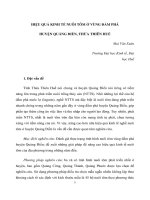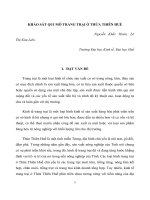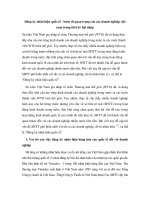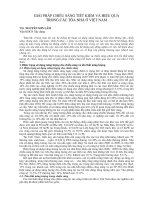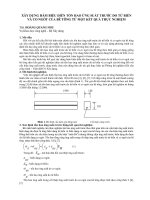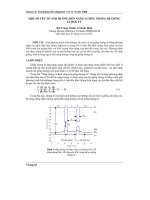Báo cáo nghiên cứu khoa học: "Thiếu máu, nhiễm trùng giun móc ở phụ nữ trong độ tuổi sinh sản ở các huyện miền núi Nam Đông, tỉnh Thừa Thiên Huế" pps
Bạn đang xem bản rút gọn của tài liệu. Xem và tải ngay bản đầy đủ của tài liệu tại đây (110.13 KB, 15 trang )
185
JOURNAL OF SCIENCE, Hue University, N
0
61, 2010
ANEMIA, MEAT CONSUMPTION AND HOOKWORM INFECTION IN
WOMEN OF REPRODUCTIVE AGE IN THE NAM DONG MOUNTAINOUS
DISTRICT, THUA THIEN HUE PROVINCE
Nguyen Van Hoa, Vo Van Thang
College of Medicine and Pharmacy, Hue University
Cynthia Ho
VU University Amsterdam
SUMMARY
Anemia is a public health concern in developing countries, especially among vulnerable
populations. The prevalence of anemia among non-pregnant women of reproductive age in the
rural communes of Vietnam is largely unknown. This study aimed to determine the prevalence of
anemia related to nutrition among women of reproductive aged living in the mountainous
communes of the Nam Dong district in Thua Thien Hue province of Vietnam. We have assessed
the prevalence of anemia, iron deficiency, and the nutritional status of these women in a
community based survey. A cross-sectional study comprised of an administered questionnaire,
laboratory analysis of hemoglobin, and serum ferrittin. The Nam Dong district is home to the
ethnic majority Kinh and ethnic minority Catu and previous studies in this district have reported
great differences in the living conditions between these two ethnicities. Of the 425 women,
36.9% were anemic and among the anemic women 40.1% were iron deficient, these women were
classified as iron deficient anemia (IDA). Although no significant association was found in the
prevalence of anemia between the two ethnic groups, 40.6% of the minority women had
moderate anemia and this was 28.0% of the Kinh women. Anemia was associated with the meat
consumption. Efforts to reduce anemia should be targeted at women with low economical and
educational level, having the occupation of farmer and belonging to the Catu ethnicity.
Key words: anemia, hookworm, reproductive age, women, ethnic, meat consumption,
mountainous.
1. Introduction
The prevalence of anemia throughout the world is high, and anemia affects
every segment of the population. The WHO estimates that mild to moderate cases are
associated with reduced physical and mental capacity. Severe cases could result in
morbidity and mortality in all population groups. Consequently, anemia is a public
health concern in many countries and leads to significant economic losses. Anemia is a
186
physical condition that is defined as having a hemeglobulin (Hb) level below a
threshold value, which could be caused by several factors. However, nutritional anemia
is the most prevalent and especially iron deficiency could contribute to the onset of
anemia. Non-nutritional factors, such as infections with malaria and hookworms and
genetic disorders play an important role as well. Nine out of ten people who suffer from
anemia live in developing countries. In rural areas the prevalence is often higher as
nutritional deficiencies and parasitic infection often prevail within the same individuals
in these areas.
Women and children are at greater risk of developing anemia, because these
groups are often more vulnerable and have a physical higher need for iron compared to
men. The consequences for them are more severe, during pregnancy anemia could lead
to a higher risk of both maternal and infant mortality and morbidity. Anemia may have
adverse effects on young children’s cognitive and motor development which are
irreversible.
Most governments in both developed and developing countries have iron
supplementation programs for pregnant women to reduce maternal anemia. Besides this,
in general, women in developing countries have less access to nutritious food, due to
their lower socio-economic position. Women living in rural areas are often involved in
heavy physical work, such as farming, which demands more nutritional intake. Hence,
non-pregnant women of reproductive age in rural areas might have a higher potential to
develop anemia. Avoiding the onset of anemia in these women may lower the possibility
of developing maternal anemia during pregnancy. Furthermore, anemia can restrict
productivity and therefore negatively affect the economy.
The situation of anemia among women in rural Vietnam is similar, especially in
the less developed areas. Surveys conducted in communes reported an average
prevalence of anemia between 37 to 50%, among the studied women. Even though,
many studies have tried to identify the risk factors of anemia, few have focused on the
underlying reasons why the study population was exposed to these. In addition, the
social determinants of health (SDH) which are defined by the WHO as: “the conditions
in which people are born, grow, live, work and age, including the health system”, are
factors that are of influence to behavior and perceptions.
The objective of the present study is to assess the prevalence of and factors
associated with anemia in reproductive aged women of the Nam Dong district of Thua
Thien Hue Province in the North Central Coast region of Vietnam.
A cross-sectional survey with biological data collection was used to reach this
objective. Comparisons of the obtained data were made between the two ethnic groups:
the Kinh and Catu. Ethnicity is a SDH which has been reported by several studies in
Vietnam to play an important role in health related issues. The results provided by this
187
study could be useful for healthcare providers and decision makers to allocate resources
and to plan effective intervention programs. It will also provide information for further
studies to identify the causal relationships between the risk factors and anemia. This
survey could serve as a baseline study for such intervention programs.
2. Methods
Survey: The survey consisted of a structured questionnaire and was
administered among the total study population. In addition, blood- and stool samples
were collected and the women’s length and weight were determined to assess the
hemoglobin (Hb) level and serum ferritin level, infection with intestinal helminthes and
the nutritional status, respectively.
Setting: The present study was conducted in the mountainous Nam Dong district,
Thua Thien-Hue province, Vietnam. It is relatively poor and contains sizable ethnic
minority populations. Malaria has been eliminated from this district. The district is
divided into one town and ten communes; each encompasses three to five villages. The
communes Hương Hữu and Thương Long were classified as having a very poor
economic status, and Khe Tre was classified as having the highest economic status by
the local authorities. Biological data was collected at commune healthcare centers
(CHC) by the healthcare staff, and the interviews were conducted at the participant’s
house by local school teachers. The collection of data was between July and August
2009, during the dry season.
Sampling: Women of reproductive age were defined in this setting as aged
between 15 and 49 years and all were eligible for the participation. The sample size was
estimated to be 425 women, based on a prevalence of anemia 35% and included a
possible 10% lost of data. A population record of the commune/town is kept at each
CHC and from these records, women between the ages 15-49 years were selected,
producing a sampling frame for each place. The subjects were chosen by simply random
selection from the sampling frames and proportionally to total number of the women
from these frames. The selected women were informed and approached by the CHC
staff to participate in the study.
Laboratory methods: Blood and stool samples were collected from each
participant. A 5ml sample of venous blood was collected using a closed collection
system into tubes containing fast clotting agent. The samples were transported on dry
ice to Hue College of Medicine and Pharmacy (2 days late) for analysis by Hematology
Service. The Hb level was measured with the KX-21 machine (Symex, Japan). The
World Health Organization (WHO) standards were used to define the anemia status
among the women: Normal: Hb levels ≥12.0 (g/dL), mild anemia: Hb levels 10.0-11.9
(g/dL), moderate anemia: Hb levels 7.0-9.9 (g/dL), severe anemia: Hb levels <70 (g/dL).
Iron deficiency was defined as a serum ferritin of <15 (ng/ml), according to the WHO
188
recommendations for women of reproductive age. Serum ferritin levels were measured
among the anemic subpopulation only. Due to the high costs of the analysis method it
was impractical to test all women. Women who were found to be anemic and iron
deficient were classified as IDA.
Stool samples were collected to screen for hookworm, Ascaris and Trichuris
infection and infection with protozoa was screened as well, using the formalin ether
technique. The women were provided with plastic bags and a wooden spatula the day
before the blood sampling and were ask to return these with their stool sample the next
day to the CHC.
Body Mass Index (BMI) was used as an indicator for the nutritional status. The
women’s weight and length were measured at the CHC during their visit for the blood
sampling. The WHO criteria for nutritional status among Asian adults were:
underweight: BMI≤18.5 kg/m
2
, normal: BMI 18-22.9 kg/m
2
, overweight: BMI ≥23
kg/m
2
.
Questionnaire: Participating women were asked to complete a questionnaire
after the collection of biological data. The questionnaire was administered by local
primary or secondary teaching staff, who received special training for this purpose. The
choice for a face to face interview was because an illiteracy rate of around 30% was
expected among the women, based on previous surveys in this area. The interviews took
place during house visits and after informed consent were obtained. Data collected,
included potential demographic risk factors for iron deficiency and hookworm infection,
dietary meat consumption, ethnic group, education, number of children, domestic
sanitary facilities and frequency of wearing shoes.
Analysis: EpiData was used to enter data and all respondents were checked for
missing biological data and incomplete questionnaires. The survey data was exported to
SPSS v15.0 for further analysis. The prevalence of anemia, iron deficiency, IDA and
BMI were calculated using the cut-off defined above. Hookworm, Ascaris, Tricuris and
infection with intestinal protozoa was classified as positive when eggs or cells were
found in the stool. BMI and hookworm infection were tested for association with
anemia and IDA. The association between certain SDH and the above mentioned were
tested, as well. All associations and differences were computed with the Chi-square test
or the Fischer’s exact test.
Ethical considerations: Ethical approval was received from the College of
Medicine and Pharmacy of Hue University and the local authority of the Nam Dong
district. In addition, the project was approved by the consultant of Community Research
Excellence of Netherlands-Vietnam project. Permission of the village heads was asked
to conduct the research project in their villages and to use local school or other
government buildings to accommodate the FGDs. Informed consent was obtained
189
before the start of the data collection. The subjects received an incentive for their
participation in the study. They received 30,000 VND for providing blood and stool.
3. Results
The demographic and socio-economic data for the 425 women of reproductive
age who participated in the study are presented in table 1. 56.9% of the total study
population belonged to the Kinh ethnicity and 41.4% to the Catu ethnicity. Because of
the small number of other ethnic minorities, three women were Pako (0.7%) and four
belonged to another minority (0.9%), it was decided to combine these and the Catu
women into one group: minority (43%), for further analysis.
The mean age of the Kinh was 33 years (SD 9.9) and that of the minority was 28
years (SD 8.4). More than three quarter of the women was married and among these the
majority had one to three children. The educational level of the Kinh women was
significantly higher than that of the minority, 24.6% of the minority women had never
received education compared to 2.9% of the Kinh women. None of the subjects had a
college or university education level. The majority of the minority women (86.9%) were
farmers and 34.7% of the Kinh women had this occupation. More than two out of three
women classified themselves to have a medium economic level. However, about one
third of the minority women had a low economic level, while this was significantly
lower for the Kinh women (2.8%). The main water source for Kinh women was a well
(66.1%) and next water from the tap (22.7%). This was significantly different for the
minority women, water from a spring (59.9%) was their main source and well water was
used by 27.3% of them. Significant differences were also found in the sanitation, 90.2%
of the minority vs. 41.7% of the Kinh used a pit as a latrine and 55% of the Kinh had a
septic tank, while this was 4.9% for the minority.
Table 1. Socio-demographic characteristics of reproductive aged women in Nam Dong district
Variables Category
Total
study
populatio
n N=425
(%)
Kinh
n=242
(%)
Minorit
y
n=183
(%)
P
*
-value
(Kinh vs.
minority)
Age (years)
15-19
20-24
25-29
30-34
35-39
40-44
13.6
13.4
18.6
16.2
13.4
12.2
12.0
9.1
12.8
15.7
16.1
18.2
15.8
19.1
26.2
16.9
9.8
4.4
<0.0001
190
45-49 12.5 16.1 7.7
Marital status
Single
Married
Widowed
Divorced
19.6
77.1
2.1
1.2
20.2
74.4
2.9
1.7
18.6
79.8
1.1
0.5
>0.05
Number of
children
No children
1-3 children
≥4 children
22.4
61.9
15.8
22.3
59.5
18.2
22.4
65.0
12.6
>0.05
Education
level
None
Primary
Secondary
High school
12.2
32.0
25.6
30.1
2.9
32.2
28.9
36.0
24.6
31.7
21.3
22.4
<0.0001
Occupation
Farmer
Salesperson
Government
employer
Housewife
Handicrafts
Other
57.2
12.7
12.9
4.2
2.1
10.8
34.7
21.1
19.4
7.0
3.7
14.0
86.9
1.6
4.4
0.5
0
6.6
<0.0001
Economic
level
High
Medium
Low
13.2
69.9
16.9
17.4
76.9
5.8
7.7
60.7
31.7
<0.0001
Water source
Well
Tap
Spring
Other
49.4
15.1
31.5
4.0
66.1
22.7
10.3
0.8
27.3
4.9
59.6
8.2
<0.0001
Sanitation
None
Pit
Two-compartment
Septic tank
0.9
62.6
2.8
33.4
0
41.7
2.9
55.0
2.2
90.2
2.7
4.9
<0.0001
191
* Chi-square test.
Table 2. Biological characteristics of women of reproductive age in Nam Dong
Variables Category
Total study
population
N=425 (%)
Kinh
n=242
(%)
Minority
n=183
(%)
P
*
-value
(Kinh vs.
minority)
Anemia
Normal
Anemic
63.1
36.9
61.6
38.4
65.0
35.0
>0.05
IDA
a
Normal
Iron deficient
59.9
40.1
67.7
32.3
48.4
51.6
0.015
Intestinal
parasitic
infection
None
Infection
b
Hookworm
Ascaris
Trichurius
Other
53.9
46.1
28.2
5.4
15.3
2.8
58.3
41.7
17.4
6.6
20.7
3.3
48.1
51.9
42.6
3.8
8.2
2.2
0.037
<0.0001
>0.05
<0.0001
>0.05
BMI
Underweight
Normal
Overweight
22.4
62.1
15.5
29.3
55.8
14.9
13.1
70.5
16.4
<0.0001
* = Chi-square test.
a = population size n=157 for IDA total, Kinh n=93 and minority n=64
b = infection with hookworm, Ascaris, Trichurius or protozoa.
Table 2 presents the biological characteristics of the women. The prevalence of
anemia among the women is 36.9% and is defined by a cut-off value of the hemoglobin
(Hb) level of Hb <12g/dL. No significant differences between the prevalence of anemia
among the Kinh and minority women were found. Though, when only the anemic
women were selected and categorized into mild (10 ≤ Hb <12 g/dL), moderate (7 ≤
Hb<10 g/dL) and severe (Hb<7 g/dL) anemia, a difference in the distribution of the
anemic condition between the ethnicities could be detected (table 3). The majority of the
anemic women had mild anemia, followed by moderate anemia and severe anemia was
rare. However, 40.6% of the anemic minority women had a moderate anemic condition
vs. 28.0% of the anemic Kinh women. The serum ferritin level was measured among the
women who were tested as being anemic (n=157). The prevalence of iron deficiency
192
anemia (IDA) among this sub population was 40.1% and significantly more minority
women had IDA (51.6%) than Kinh women (32.3%). The Body Mass Index (BMI)
served as an indicator for possible malnutrition and the women were divided into one of
the three categories: underweight, normal or overweight. More than one out of the seven
women was overweighed (15.5%) and more than one out of the five women was
underweighted (22.4%). The majority of the women had a normal BMI (62.1%).
Interestingly, the minority women had a significant higher BMI value.
Table3. The percentage distribution of the anemic condition.
Anemic condition
Total anemic
n=157 (%)
Kinh
n=93 (%)
Minority
n=64 (%)
Mild 61.1 66.7 53.1
Moderate 33.1 28.0 40.6
Severe 5.7 5.4 6.3
Table 4. The percentage distribution of the anemic conditions and the SDH.
SDH
Percentage distribution of Anemia (%)
N=425
P
*
-value
normal mild moderate severe
Economy
High
Average
Low
16.6
61.6
15.3
6.3
78.1
15.6
11.5
63.5
25.0
0
66.7
33.3
0.051
Occupation
Salesperson
Government employer
Housewife
Farmer
Handicrafts
Other
13.1
13.1
3.4
57.5
1.9
11.2
14.6
13.5
7.3
49.0
4.2
11.5
7.7
11.5
3.8
69.2
0
7.7
11.1
11.1
0
66.7
0
11.1
>0.05
Educational level
None
13.8
6.3
17.3
0
>0.05
193
Primary
Secondary
High school
29.9
27.2
29.1
36.5
24.0
33.3
30.8
21.2
30.8
55.6
22.2
22.2
*=Fischer’s exact test
The percentage distribution of the different anemic conditions among the women
in relation with some of the SDH is presented in table 4. A weak association was found
between the anemia and economic level. Overall, the majority of all the anemic
conditions had an average economic level. However, 15.3% of the normal women had a
low economic level, for the mild 15.6%, moderate 25.0% and severe 33%. None of the
severe cases had a high economic level and the highest percentage of women with a
high economic level could be found among the normal women. The association
between occupation and anemia was not significant, but slightly more moderate and
severe anemic women were farmers. No association between anemia and educational
level was found in this study, although to some extent more anemic women had a
primary education when compared with normal women.
Table 5. The percentage distribution of and the SDH meat intake in servings/week
SDH
Meat intake in servings/week (%)
N=425
P
*
-value
<1 1-2 3-4 5-7
Economy
High
Average
Low
5.4
10.8
40.3
33.9
45.8
54.2
42.9
37.0
5.6
17.9
6.4
0
<0.0001
Occupation
Salesperson
Government employer
Housewife
Farmer
Handicrafts
Other
7.4
1.8
0
23.0
11.1
4.3
35.2
21.8
50.0
52.3
44.4
50.0
48.1
60.0
44.4
20.6
44.4
37.0
9.3
16.4
5.6
4.1
0
8.7
<0.0001
Educational level
None
42.3
44.2
11.5
1.9
<0.0001
194
Primary
Secondary
High school
13.2
9.2
10.9
50.7
48.6
38.3
30.1
37.6
39.1
5.9
4.6
11.7
Ethnicity
Kinh
Minority
2.5
31.7
40.9
51.9
48.8
10.9
7.9
5.5
<0.0001
*Fischer’s exact test
Meat consumption was found to be significantly associated with anemia status
(P-value <0.05, Fischer’s exact test), higher meat intake resulted into less severe anemia.
However, no significant association with anemia among the total study population and
IDA was found. The relationship between meat intake and some of the SDH was
assessed and presented in table 5, to consider the influence of the SDH on the
nutritional practices. The economic level of the women was found to be significantly
positive associated with the meat intake in servings per week. Of the category five to
seven servings/weak, 17.9% had high economical level, 6.4% had average economical
level and none of these women had low economical level. For the women that served
less than once a week meat this was 5.4%, 10.8% and 40.3% respectively. Meat intake
was also associated with occupation: government employees and salespersons that, in
general, have more income had more servings of meat/week when compared to farmers.
Educational level and ethnicity were both associated with meat intake. Women with
higher education had more servings of meat when compared to women with a lower
education. Kinh women had more meat servings than women from ethnic minorities.
Table 6. Survey data of the mean food consumption per week
Food item (Servings/week)
Total
Mean ± SD
N=425
Kinh
Mean ± SD
n=242
Minority
Mean ± SD
n=183
Meat 2.31 ± 0.81 2.62 ± 0.67 1.90 ± 0.80
Fish 2.97 ± 0.90 3.21 ± 0.79 2.64 ± 0.93
Vegetables 3.68 ± 0.69 3.65 ± 0.69 3.72 ± 0.70
Eggs 1.65 ± 0.68 1.85 ± 0.67 1.38 ± 0.59
Fruit 2.19 ± 0.89 2.44 ± 0.79 1.86 ± 0.83
Soya bean products 1.73 ± 0.76 2.09 ± 0.74 1.25 ± 0.47
Table 6 presents the survey data of the mean nutritional intake of the women per
195
week. In overall, this table shows that the Kinh women had a more variable diet as they
consumed more of all the food items. Only vegetables were consumed slightly more
times a week by the minority women, and these were consumed most frequently by all
women, the mean consumption was 3.68 (SD 0.69) times per week. Fish was the next
most frequent, 2.97 times per week (SD 0.9), followed by meat 2.31 (SD 0.81), fruit,
soya bean products and eggs.
4. Discussion
We found that the prevalence of anemia among the women is 36.9%. The
prevalence in Nam Dong district is comparable to that of a survey in the Yen Bai
province, northwest of Vietnam, where 37.5% of the non-pregnant women were found
to be anemic. However, the prevalence of anemia differs between the communes
ranging from 27.3% to 48.1%. A prevalence of ≥40% is categorized as a severe public
health problem by the WHO standards.
No significant association between ethnicity and anemia was found, and more
than half of the anemia cases in both groups were mild, and severe anemia was rare.
However, 40.6% of anemic minority women had moderate anemia and 28.0% of the
anemic Kinh had this condition. The severity of anemia is categorized into three degrees
corresponding to the Hb level value: mild (10≤Hb<12g/dL), moderate (7≤Hb<10g/dL)
and severe (Hb<7g/dL). The health risk of anemia increases with severity, and therefore
the consequences of moderate anemia are more severe than that of mild anemia. In
addition, increasing the dietary intake of iron could be successful against mild anemia,
but may be insufficient for moderate-to-severe anemia.
Among the anemic women, 40.1% had iron deficiency and were therefore
classified as IDA. The high prevalence of IDA suggests that iron deficiency is a major
contributor to anemia and especially among the minority women. A significant
association between ethnicity and the prevalence of IDA was found, 51.6% of the ethnic
minority was IDA and 32.2% of the ethnic Kinh. IDA was not associated with meat
intake, but hookworm infection was, these findings will be discussed in the sections
about nutrition and IHI.
A weak association was found between economical level and anemia and no
association with occupation and educational level have been found. However, these
three SDHs are strongly linked together, as people from families with a higher income
often have better educational chances and education improve living and working
conditions.
BMI is often used as an indicator for the nutritional status of a population and
was significantly associated with anemia in a health survey among women in Mali.
This study did not find any significant relationship between BMI and anemia or IDA.
Anemia is caused mainly by a deficiency in micronutrients and low BMI is perhaps
196
poor indicator for this. The minority women in overall had a higher BMI value
compared to the Kinh and this could probably be the result of the mainly starch based
diet of these women. Because several studies had reported an association between meat
consumption and anemia, it was decided to use meat intake instead of BMI to assess the
relationship between the SDH and nutrition. Meat consumption was significantly
associated with the anemic condition, the educational and economical level of the
women, occupation and ethnicity. Against the expectancy, meat consumption was not
associated with IDA, meat has a high iron bioavailability. However, a trend could be
detected, as less women that had 3-7 servings of meat/week were iron deficient
compared to women that had 1-2 servings/week.
Only vegetables were consumed slightly more by ethnic minorities, and often
these were homegrown, which could be related with the high percentage of farmers
(89.6%) among these women. Of the Kinh women 34.7% were farmers, 21.1%
salesperson and 19.4% government employers, these numbers might be an additional
explanation for why Kinh women have to buy their food more often. These findings are
common for rural areas with a high percentage of minorities. The ethnic Kinh have
more access to fertile land, which results in higher productivity and rely more on
industrial crops than on low-value staple crops. Often their farm income is
supplemented with trading or services. While minorities depend more on traditional
agriculture, it results in lower productivity. This explains why Catu women
supplemented their diet with food collection in the forest as a result of less fertile land
and less income. The intake of wild vegetables among minority women was found to be
more frequent in the Central Highlands and Mekong Delta by a survey conducted by
Ogle et al 2001.
The prevalence of hookworm, Ascaris and Trichurius infection among the
reproductive aged women in the Nam Dong district were 28.2%, 5.4% and 15.3%,
respectively. These are significantly lower compared to a survey among reproductive
aged women in the Central North Coast region (1995), which Nam Dong district is a
part of. This survey reported a prevalence of 67.5% for hookworm, 80.8% for Ascaris
and 62.4% for Trichurius.
No association with intestinal parasitic infection and anemia were found among
the study population. Several studies have reported no association between Ascaris or
Trichurius infection and anemia, while association between hookworm infection and
IDA were found. The highest parasitic infection was with hookworm (28.2%) and this
was especially high among the ethnic minorities (42.6%) and the infection rate with
Trichurius was 16.3% and was significantly higher among the ethnic Kinh (20.7%). An
association between hookworm infection and IDA was found by this study.
Hookworm infection among the women was significantly associated with a
lower education and lower economical level, having an occupation as farmer and not
197
using a septic tank as the type of latrine. A significant difference in sanitation between
the two ethnic groups was found, 90.2% of the ethnic minority had a pit as latrine while
this was 41.7% for the ethnic Kinh, and most of the Kinh women (55%) had a septic
tank. A problem with pit latrines is contamination of the environment with infective
agents when these pits are not well constructed, treated with chemicals or emptied on
time. Especially during the rainy season when flooding are common for this area and
the content of the pit is disposed into the environment. The high rates of ethnic Kinh
having a septic tank as latrine might be explained by the more developed communes in
which they often live in. The lower developed communes are more inhabited by the
ethnic minorities, which may lack a proper sewage system to support a septic tank toilet.
The association between the water source and hookworm infection was not
tested, because infection occurs through the skin and not by ingestion. However, the
infection of Trichurius and Ascaris could be related to the water source as infection with
these intestinal worms occurs through ingestion of the eggs. A significant difference
between the water source and ethnicity was found, the main water source of the ethnic
Kinh was a well (66.1%) and tap water was used by more than one fifth of these women.
The minorities used spring water (59.6%) and water from a well (27.3%). Water from a
spring or well are open water sources and have a higher risk of contamination with
infective agents. However, the infection with Tricurius, Ascaris and protozoa was
higher among the ethnic Kinh (30.6%) compared to the minority (14.2%).
The survey data showed that most of the Kinh women never walked barefoot,
while this was slightly more than half for the minorities. 13.1% of the ethnic minority
always walked barefoot and the most frequently because wearing sandals or shoes was
not a habit for them.
Hand washing before a meal and after leaving the toilet was a practice among
most Kinh women and around half of the ethnic minority had these practices. Most
women gave hygiene as reason for doing this. Minority women reported unavailability
of water, forgetting, and not a habit as reasons for not washing their hands. The main
water source for minority was a spring and perhaps the greater distance to this water
source, in general, compared to other sources might inhibit the women to wash their
hands. In addition, more ethnic minority women are engaged in farming and hand
washing might be impractical, since their hands get dirty all the time during work.
5. Conclusion
Anemia was a moderate public health problem among the reproductive aged
women in the Nam Dong district and more than 40% was attributed to iron deficiency.
The majority of anemic cases were mild among all women, but the ethnic minority had
a higher prevalence of moderate anemia. The anemia was not significantly associated
with SDH; economical, educational level, occupation and ethnicity. However, the
198
anemic condition was associated with meat intake and hookworm infection and these
were significantly associated with the SDH.
Meat consumption was associated with occupation, education and economical
level and meat consumption was significantly higher among the ethnic Kinh compared
to the ethnic minority.
Hookworm infection was associated with sanitation, occupation, educational and
economical level and a significant difference in the prevalence of hookworm infection
had been found between the ethnic Kinh and minority.
Further study to define the other causes of anemia will be important for planning
national anemia prevention strategies.
REFERENCES
1. Pasricha, S.R., et al., A community based field research project investigating
anaemia amongst young children living in rural Karnataka, India: a cross
sectional study. BMC Public Health. 2009; 9: 59.
2. Kilbride, J., et al., Anaemia during pregnancy as a risk factor for iron-
deficiency anaemia in infancy: a case-control study in Jordan. Int J
Epidemiol. 1999; 28 (3): 461-8.
3. Zimmerman, M. and K. Kraemer, eds. Nutritional anemia. Sight and life.
414, 2007.
4. Allen, L.H., Anemia and iron deficiency: effects on pregnancy outcome. Am
J Clin Nutr. 2000; 71 (5 Suppl): 1280-4.
5. Singh, M.B., R. Fotedar, and J. Lakshminarayana, Micronutrient deficiency
status among women of desert areas of western Rajasthan, India. Public
Health Nutr. 2009; 12(5): 624-9.
6. Galloway, R. and E. al., Women’s perceptions of iron deficiency and anemia
prevention
7. and control in eight developing countries. Social Science & Medicine. 2002;
55: 529-544.
8. Thang, N.M. and B.M. Popkin, In an era of economic growth, is inequity
holding back reductions in child malnutrition in Vietnam? Asia Pac J Clin
Nutr, 2003; 12(4): 405-10.
9. Pasricha, S.R., et al., Anemia, iron deficiency, meat consumption, and
hookworm infection in women of reproductive age in northwest Vietnam. Am
J Trop Med Hyg. 2008; 78(3): 375-81.
199
10. Gilgen, D. and C.G. Mascie-Taylor, The effect of weekly iron
supplementation on anaemia and on iron deficiency among female tea
pluckers in Bangladesh. J Hum Nutr Diet. 2001; 14(3): 185-90.
11. Le Hung, Q., et al., Anemia, malaria and hookworm infections in a
Vietnamese ethnic minority. Southeast Asian J Trop Med Public Health.
2005; 36(4): 816-21.
